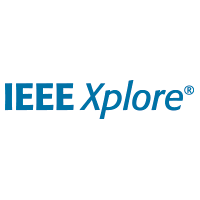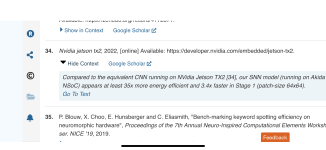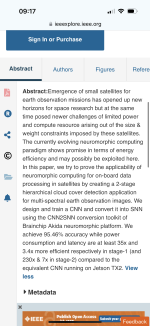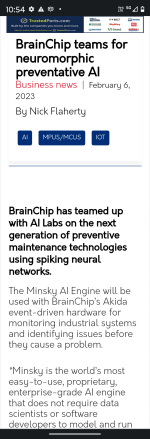You are using an out of date browser. It may not display this or other websites correctly.
You should upgrade or use an alternative browser.
You should upgrade or use an alternative browser.
BRN Discussion Ongoing
- Thread starter TechGirl
- Start date
Damo4
Regular
Learning 🏖
Currently listening, just wanted to point out they are changing the NED remuneration structure to include a minimum BRN stock holding.
Hopefully that's higher than the RSU's everyone is given, otherwise it's just a no-sell policy.
GStocks123
Regular
Quite a lot on SNN research including Akida. Unfortunately link regarding NVIDIA is no longer available 

 ieeexplore.ieee.org
ieeexplore.ieee.org

Low Power & Low Latency Cloud Cover Detection in Small Satellites Using On-board Neuromorphic Processors
Emergence of small satellites for earth observation missions has opened up new horizons for space research but at the same time posed newer challenges of limited power and compute resource arising out of the size & weight constraints imposed by these satellites. The currently evolving...
Attachments
GStocks123
Regular
More on the most recent TCS research paper. I like it a lot!

 ieeexplore.ieee.org
ieeexplore.ieee.org

Bringing Touch to the Edge: A Neuromorphic Processing Approach For Event-Based Tactile Systems
The rise of neuromorphic applications has highlighted the remarkable potential of biologically-inspired systems. Despite significant advancements in audio and visual technologies, research directed towards tactile sensing has not been as extensive. We propose a neuromorphic tactile system for...
Attachments
Fastback6666
Regular
If it’s new interest then they would have to fully test and validate the 2nd Generation product. Real revenue would most likely be some time away for newcomers.From the last Quarterly report it was stated therein that:
"The Company is currently experiencing its highest ever level of commercial engagements, the volume and quality of which are improving rapidly as a larger number of customers learn about BrainChip and our 2nd Generation technology which will be available in late Q3."
Also let's all hope that where the Co say's : "The Company is currently experiencing its highest ever level of commercial engagements "...... IMO...translate's into an increased revenue stream in this upcoming 4C.
I hope that these Co statements are correct and just not mere off the cuff feel good " Fluff " statements.
We need to see the long term partners finished product(s) and starting revenue from those engagements. They cut their teeth in 1st generation and then bang in the 2nd generation….hopefully some revenue in the next 12 months somewhere.
I am wondering if the upcoming launch of Akida Gen 2.0 has already been factored into the current S/Price ??? ........... imo, I think the only thing that will these days create S/price momentum from here on out will be the disclosure of any new IP Licensing/s.G'day Rise,
You need to watch the movie (Highlander). Queen did the sound track (see: It's a kind of magic) An immortal dealing with the loss of the mortals he loved.
Hmm.....I think this is getting a bit weird.
So....
Back to BRN..
The Akida 1500 must be on the test bench by now. Am I wrong to think that it was cooked up for a long standing EAP customer? Not so fussed with Akida 2.0, It's years away by the time it is taped out and then tested. Then again, news of its launch may be positive for the SP.
Yes that's something a lot of people don't realise. Akida 2.0 might already factored in the current declining SP.I am wondering if the upcoming launch of Akida Gen 2.0 has already been factored into the current S/Price ??? ........... imo, I think the only thing that will these days create S/price momentum from here on out will be the disclosure of any new IP Licensing/s.
We are just waiting for commercial agreements - which generally take months or years after testing and further changes/upgrades to Akida 2.0 before signing any agreement.
I personally hope that ARM, once they actually list on the Nasdaq IPO within the very near future will have substantial funds set aside for Co acquisitions, mergers etc etc as part of their overall ongoing commercial and corporate strategies ........ it would be beneficial and make sense for ARM to take some kind of a financial stake no matter what size interest big or small ( but meaningful ) in Brainchip, especially given that they know of our Co, as well as most importantly incorporating / promoting our Akida AI technology within their own ARM products.On the surface a good idea.
However BRCHF hit a 52 week low today (hard to fathom with so many good thing in the hopper and vastly increased tech recognition of neuromorphic whatever).
But a company doesn't want to merge or be acquired at a low valuation.
Possible first step to spark valuation is to have a BIG NAME take a 10% stake.
Double overnight and find itself on investors stock screens.
Enough with the anonymity!!
supersonic001
Regular
BrainChip Chair Antonio J. Viana Addresses Investors in Two-Part Investor Podcast | BrainChip
BrainChip Chair Antonio J. Viana Addresses Investors in Two-Part Investor Podcast - https://lnkd.in/g9d-c7DY #edgeAI #AI #neuromorphic #aritificialintelligence #podcast
Cartagena
Regular
Another article I found mentions ARM and how Akida "will be" paired with their processor to provide AI capability.
Based on what we know, this is the M85 Cortex.
The main part which really validates my investment and excites me is this:
In this case, MegaChips’ partner, BrainChip, is an example of an accelerator that would be combined with the existing embedded processors.
The AI ARM connection is real and happening. Our patience will be rewarded.
Attachments
Tothemoon24
Top 20
Dear Mr Sean Hehir
I’m not sure how things work in America
In Australia as children going to school we start our learnings doing finger painting , then we learn to use crayons for drawing & start to learn how to spell our names .
We then advance to using a pencil, once we reach a certain level we start to use what’s called a pen , we need to be advanced in this art form to achieve our pen licence.
If you’re unaware Mr Hehir a pen is used for very important documents, like witnessing the signing of contracts.
Please see the below artist impression of how to use such a tool
artist impression of how to use such a tool

 .
.
I’m not sure how things work in America
In Australia as children going to school we start our learnings doing finger painting , then we learn to use crayons for drawing & start to learn how to spell our names .
We then advance to using a pencil, once we reach a certain level we start to use what’s called a pen , we need to be advanced in this art form to achieve our pen licence.
If you’re unaware Mr Hehir a pen is used for very important documents, like witnessing the signing of contracts.
Please see the below
What if he is left handed ??? !!!Dear Mr Sean Hehir
I’m not sure how things work in America
In Australia as children going to school we start our learnings doing finger painting , then we learn to use crayons for drawing & start to learn how to spell our names .
We then advance to using a pencil, once we reach a certain level we start to use what’s called a pen , we need to be advanced in this art form to achieve our pen licence.
If you’re unaware Mr Hehir a pen is used for very important documents, like witnessing the signing of contracts.
Please see the belowartist impression of how to use such a tool

.
Well, our Podcast was delivered as per expected this week, with an added bonus (if you like) with another part next week.
Both Tony and Antonio spoke very clearly, Antonio was his usual thoughtful self, keeping things in prospective, what I'd call,
stating our current position in an honest controlled manner, no fluff, and that's what I like.
He backed up Sean's comment/s with regard "our engagement level and quality have improved radically"
I'd listen to the Podcast again between 16m 30s and 18m 39s.
He has nailed it very clearly as to why a number of shareholders keep asking why, why, why....listen carefully as I believe
that he explained it beautifully.
The long game, despite being a little longer than I had personally planned for.
Tech
Both Tony and Antonio spoke very clearly, Antonio was his usual thoughtful self, keeping things in prospective, what I'd call,
stating our current position in an honest controlled manner, no fluff, and that's what I like.
He backed up Sean's comment/s with regard "our engagement level and quality have improved radically"
I'd listen to the Podcast again between 16m 30s and 18m 39s.
He has nailed it very clearly as to why a number of shareholders keep asking why, why, why....listen carefully as I believe
that he explained it beautifully.
The long game, despite being a little longer than I had personally planned for.
Tech
Punctuation - full stop after final "use", exclamation mark after "tool".Dear Mr Sean Hehir
I’m not sure how things work in America
In Australia as children going to school we start our learnings doing finger painting , then we learn to use crayons for drawing & start to learn how to spell our names .
We then advance to using a pencil, once we reach a certain level we start to use what’s called a pen , we need to be advanced in this art form to achieve our pen licence.
If you’re unaware Mr Hehir a pen is used for very important documents, like witnessing the signing of contracts.
Please see the belowartist impression of how to use such a tool

.
Honestly speaking, the commercial progress has been slower than i expected. I expect things to change once Gen 2 is available in September.
When i started investing in the company, i started with a target to accumulate 50k shares. I kept accumulating slowly at every opportunity. The average is higher than what i would like it to be but with my buy today of another $5k at .34, i have taken my holdings to 201k shares. I am now waiting patiently for the better days to come. Go BRN
When i started investing in the company, i started with a target to accumulate 50k shares. I kept accumulating slowly at every opportunity. The average is higher than what i would like it to be but with my buy today of another $5k at .34, i have taken my holdings to 201k shares. I am now waiting patiently for the better days to come. Go BRN
MDhere
Top 20
Cleverly crafted CNN @chapman89 and fellow Brners 

 ieeexplore.ieee.org
ieeexplore.ieee.org

NNTrak: A Neural Network Approach Towards Calculating Air-Writing Trajectories in Real-Time with a Smartwatch
Tracking arm motion in real-time with wearables like smartwatches has proved to be a challenging task. Ex-isting approaches either require additional sensing modality affecting ubiquity, and/or are not efficient enough for real-time tracking, especially on low-power embedded devices with limited...
Bravo
If ARM was an arm, BRN would be its biceps💪!
Cruise isn't having such a good time of it as late. The results of this accident are pretty concrete. 


 www.nytimes.com
www.nytimes.com

Driverless Car Gets Stuck in Wet Concrete in San Francisco (Published 2023)
Though driverless cars have not been blamed for any serious injuries or crashes in the city, they have been involved in several jarring episodes.
Fastback6666
Regular
For sure, most of the Akida 2.0 release is known and factored- you can get a short term pump in the SP over the company news of 2.0 released but until there is a larger and consistent revenue stream confirmed in a deal/contract or seen in the quarterly, then our price is probably not going to move a great deal.Yes that's something a lot of people don't realise. Akida 2.0 might already factored in the current declining SP.
We are just waiting for commercial agreements - which generally take months or years after testing and further changes/upgrades to Akida 2.0 before signing any agreement.
Another thing that has damaged the SP is the general sell off in the sharemarket of riskier tech stocks. I mean risky as in: they have not achieve Cash flow positive territory and established themselves as money maker. General market sentiment to risk stocks can change in the future and have the ability for insto’s to start buying into risk stocks in bulk again, but this will still take time/years to get out of this risk adverse market sentiment.
While high interest is in place the insto’s will just make easy money on high interest bonds and other large profit making companies. Too easy for them and no need to buy risk stocks.
More waiting in many ways for us unfortunately.
Similar threads
- Replies
- 0
- Views
- 4K
- Replies
- 7
- Views
- 5K
- Replies
- 0
- Views
- 3K



